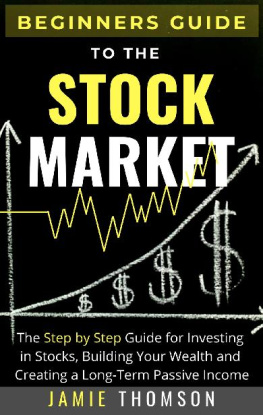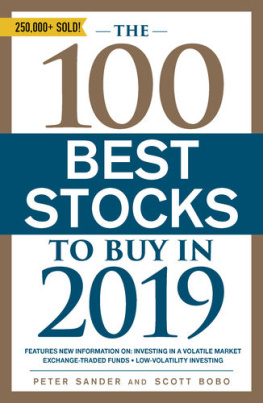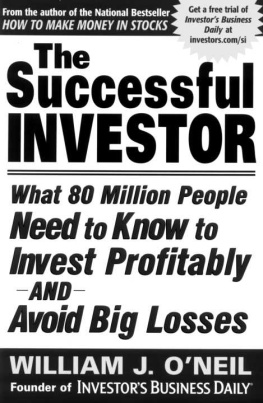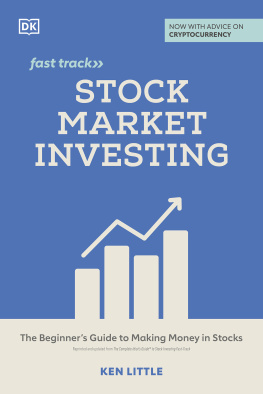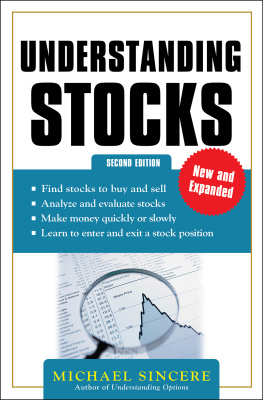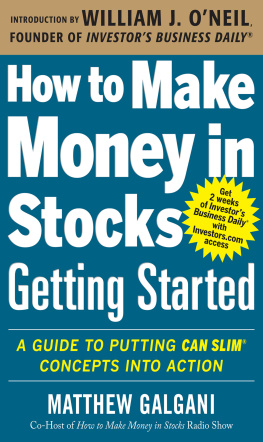How to Make Money in Stocks
How to Make Money in Stocks
A WINNING SYSTEM IN
GOOD TIMES OR BAD
FOURTH EDITION
WILLIAM J. ONEIL


Copyright 2009, 2002 by William J. ONeil; 1995, 1991, 1988 by The McGraw-Hill Companies, Inc. All rights reserved. Except as permitted under the United States Copyright Act of 1976, no part of this publication may be reproduced or distributed in any form or by any means, or stored in a database or retrieval system, without the prior written permission of the publisher.
ISBN: 978-0-07-161414-6
MHID: 0-07-161414-1
The material in this eBook also appears in the print version of this title: ISBN: 978-0-07-161413-9, MHID: 0-07-161413-3.
All trademarks are trademarks of their respective owners. Rather than put a trademark symbol after every occurrence of a trademarked name, we use names in an editorial fashion only, and to the benefit of the trademark owner, with no intention of infringement of the trademark. Where such designations appear in this book, they have been printed with initial caps.
McGraw-Hill eBooks are available at special quantity discounts to use as premiums and sales promotions, or for use in corporate training programs. To contact a representative please e-mail us at bulksales@mcgraw-hill.com.
This publication is designed to provide accurate and authoritative information in regard to the subject matter covered. It is sold with the understanding that neither the author nor the publisher is engaged in rendering legal, accounting, or other professional service. If legal advice or other expert assistance is required, the services of a competent professional person should be sought.
From a Declaration of Principles jointly adopted
by a Committee of the American Bar
Association and a Committee of Publishers
This text contains the following, which are trademarks, service marks, or registered trademarks of Investors Business Daily, Inc., William ONeil + Co. Incorporated, or their affiliated entities in the United States and/or other countries: Investors Business Daily, IBD, CAN SLIM, SmartSelect, ACC/DIS RTG, SMR, Stock Checkup, Stocks on the Move, Daily Graphs, Daily Graphs Online, ONeil Database, and The William ONeil + Co. 197 Industry Groups.
TERMS OF USE
This is a copyrighted work and The McGraw-Hill Companies, Inc. (McGraw-Hill) and its licensors reserve all rights in and to the work. Use of this work is subject to these terms. Except as permitted under the Copyright Act of 1976 and the right to store and retrieve one copy of the work, you may not decompile, disassemble, reverse engineer, reproduce, modify, create derivative works based upon, transmit, distribute, disseminate, sell, publish or sublicense the work or any part of it without McGraw-Hills prior consent. You may use the work for your own noncommercial and personal use; any other use of the work is strictly prohibited. Your right to use the work may be terminated if you fail to comply with these terms.
THE WORK IS PROVIDED AS IS. McGRAW-HILL AND ITS LICENSORS MAKE NO GUARANTEES OR WARRANTIES AS TO THE ACCURACY, ADEQUACY OR COMPLETENESS OF OR RESULTS TO BE OBTAINED FROM USING THE WORK, INCLUDING ANY INFORMATION THAT CAN BE ACCESSED THROUGH THE WORK VIA HYPERLINK OR OTHERWISE, AND EXPRESSLY DISCLAIM ANY WARRANTY, EXPRESS OR IMPLIED, INCLUDING BUT NOT LIMITED TO IMPLIED WARRANTIES OF MERCHANTABILITY OR FITNESS FOR A PARTICULAR PURPOSE. McGraw-Hill and its licensors do not warrant or guarantee that the functions contained in the work will meet your requirements or that its operation will be uninterrupted or error free. Neither McGraw-Hill nor its licensors shall be liable to you or anyone else for any inaccuracy, error or omission, regardless of cause, in the work or for any damages resulting therefrom. McGraw-Hill has no responsibility for the content of any information accessed through the work. Under no circumstances shall McGraw-Hill and/or its licensors be liable for any indirect, incidental, special, punitive, consequential or similar damages that result from the use of or inability to use the work, even if any of them has been advised of the possibility of such damages. This limitation of liability shall apply to any claim or cause whatsoever whether such claim or cause arises in contract, tort or otherwise.
CONTENTS
Part I:
A Winning System: CAN SLIM
Introduction You Can Learn and Benefit from Americas
100 Years of Super Winners
CHAPTER 2 How to Read Charts Like a Pro and Improve
Your Selection and Timing
CHAPTER 5 N = Newer Companies, New Products, New Management,
New Highs Off Properly Formed Bases
Part II:
Be Smart from the Start
CHAPTER 12 Money Management: Should You Diversify, Invest for the Long
Haul, Use Margin, Sell Short, Buy Options, IPOs, Tax Shelters,
Nasdaq or Foreign Stocks, Bonds, Etc.?
Part III:
Investing Like a Professional
PART I
A Winning System: CAN SLIM
INTRODUCTION
You Can Learn and Benefit from Americas 100 Years of Super Winners
After the market debacles of 2000 and 2008, most investors now know that they need to take charge and learn much more about what theyre doing when they save and invest their hard-earned money. However, many investors dont know where to turn, whom to trust, or what they must stop doing if they are to achieve dramatically superior investment performance.
You dont have to give your money to a Bernie Madoff, wholl take it but wont tell you exactly what hes doing with it. Instead, you can and should read a few good investment books, attend some investment classes, or participate in an investment meet-up group so that you can learn how to invest with real confidence. At the very least, you should learn and understand well the sound principles and proven rules and methods that will protect and build your investment portfolio over time. Half of all Americans save and invest; now its time to learn to do it intelligently with critical knowledge.
When I started investing, I made most of the same mistakes youve probably made. But heres what Ive learned:
- You should buy stocks when theyre on the way up in price, not on the way down. And when you buy more, you do it only after the stock has risen from your purchase price, not after it has fallen below it.
- You buy stocks when theyre nearer to their highs for the year, not when theyve sunk so low that they look cheap. You buy higher-priced stocks rather than the lowest-priced stocks.
- You learn to always sell stocks quickly when you have a small loss rather than waiting and hoping theyll come back.
- You pay far less attention to a companys book value, dividends, or PE ratiowhich for the last 100 years have had little predictive value in spotting Americas most successful companiesand focus instead on more important proven factors such as profit growth, price and volume action, and whether the company is the number one profit leader in its field with a superior product.
- You dont subscribe to a bunch of market newsletters or advisory services, and you dont let yourself be influenced by recommendations from analysts, who, after all, are just expressing personal opinions that can frequently be wrong.
Next page

